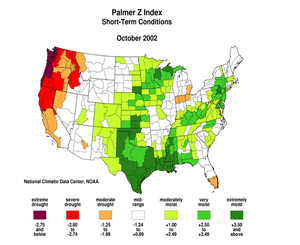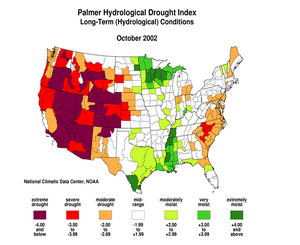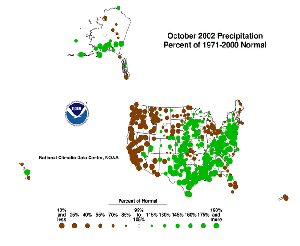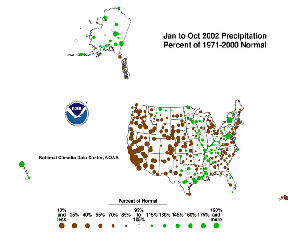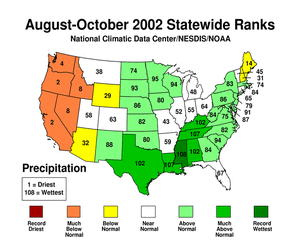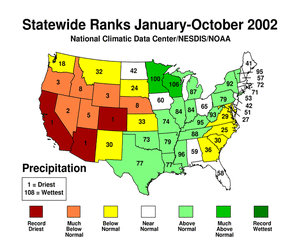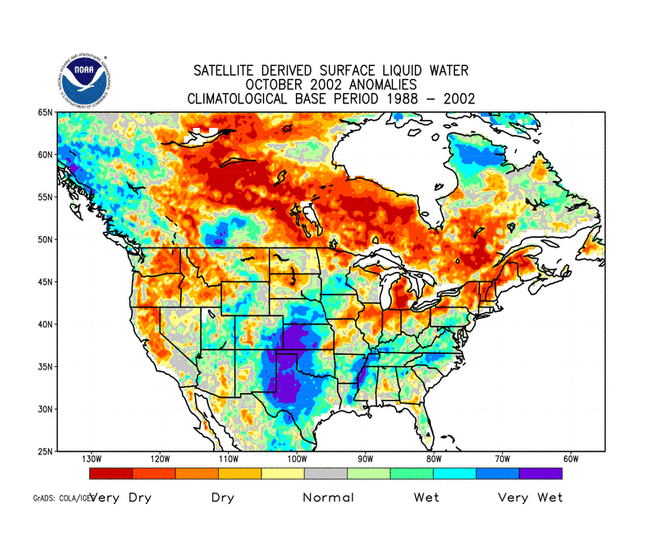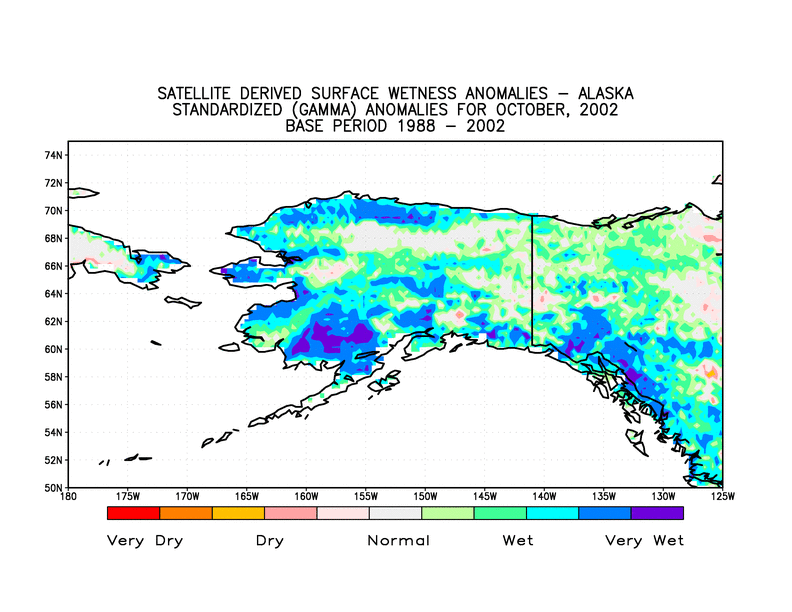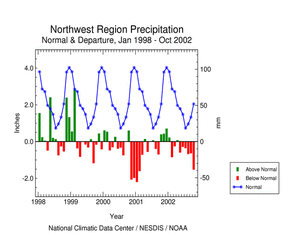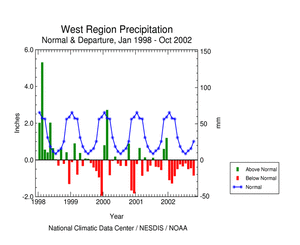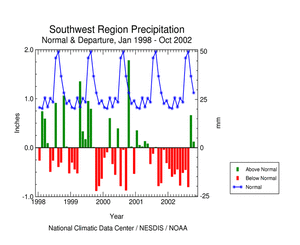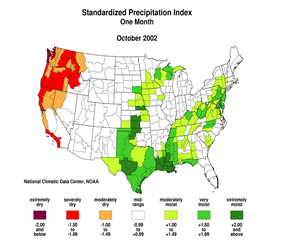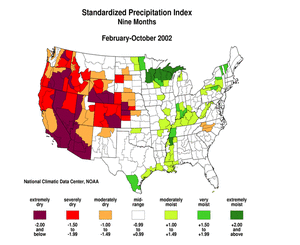U.S. Drought Highlights:
- On the national scale, severe to extreme drought affected about 28 percent of the contiguous United States as of the end of October 2002
- moderate to extreme drought affected about 37 percent of the contiguous U.S.
- Short-term conditions improved across much of the country from the Rockies eastward, however long-term moisture deficits continued in parts of the central and southern Plains and much of the east coast
- Much of the far western U.S. continued to suffer from drought, both short-term and long-term
Please Note: The data presented in this drought report are preliminary. Ranks, anomalies, and percent areas may change as more complete data are received and processed.
National Overview
On the national scale,
- about 37 percent of the contiguous U.S. fell in the moderate to extreme drought categories (based on the Palmer Drought Index) at the end of October;
- severe to extreme drought affected about 28 percent of the contiguous United States as of the end of October 2002;
- this is the third consecutive month of decreasing areal coverage of drought
- the coverage of the current ( 1999-present) national-scale drought first peaked in August 2000 at about 36% of the contiguous U.S., which was as extensive as the major droughts of the last 40 years, but not as large as the "dust bowl" droughts of the 1930s and 1950s;
- the total drought area decreased to about 10 percent by November 2000, but has shown a general increasing trend for much of the period since then, reaching in July 2002 the peak it had first reached in August 2000 (see graph below left);
- on a broad scale, the last two decades were characterized by unusual wetness with short periods of extensive droughts, whereas the 1930s and 1950s were characterized by prolonged periods of extensive droughts with little wetness (see graph below right);
- although various parts of the U.S. have experienced unusually wet conditions during the last 36 months, little change occurred in the aggregate national wetness picture during much of this period;
- the percentage of the nation severely wet has remained below about eleven percent during this period, reaching about 7 percent by the end of October 2002 (see graph below left);
- a file containing the national monthly percent area severely dry and wet from 1900 to present is available;
- historical temperature, precipitation, and Palmer drought data from 1895 to present for climate divisions, states, and regions in the contiguous U.S. are available at the Climate Division: Temperature-Precipitation-Drought Data page in files having names that start with "drd964x" and ending with "txt" (without the quotes).
Regional Overview
October 2002 was wet across much of the country from the Rocky Mountains to the east coast. Beneficial rains fell in many of the drought areas, bringing short-term relief. However, long-term moisture deficits remained in parts of the east at the 12-month and 24-month timescales.
The month was dry across the Far West and parts of southern Florida and the southern Great Lakes. Severe to extreme long-term drought continued from the west coast to the central Plains.
The October rainfall pattern was mixed at the primary stations in Hawaii. In Puerto Rico, rainfall was below normal at many stations for October, the last 4 weeks, and the last 8 weeks. In Alaska, the precipitation pattern at the primary stations was mixed, but on the whole the state had a wet month.
These overall conditions are evident in the following indicators:
- the runoff, evaporation, and soil moisture conditions as calculated by the National Weather Service,
- maps showing the percent of normal precipitation for airport stations for the current month and year-to-date,
- the percent of average precipitation map for October for the SNOTEL stations in the western mountains provided by the USDA Water and Climate Center,
- the percent of average snow water content map for early October for the SNOTEL stations in the western mountains provided by the USDA Water and Climate Center,
- the statewide precipitation ranks for current month (short-term) and 3-months, 6-months, year-to-date, and 12 months (longer-term),
- the short-term surface wetness anomaly map for October computed by the National Climatic Data Center from the Special Sensor Microwave Imager (SSMI), a polar orbiting satellite with global coverage, and
- the USGS October daily streamflow maps.
Western U.S. Drought
The west coast's wet season got off to a dry start this year. October 2002 marked the latest in a string of consecutive drier than normal months for both the Northwest and West regions. For the Northwest, the regional dryness extends back through the normally dry summer season, but for the West region the dryness goes back to January, which was the middle of the last wet season.
According to early USDA reports, the dryness in the Northwest was taking a toll on the young winter wheat crop. In particular, Oregon wheat -- just 27% emerged (5-year average is 63%) due to cold, dry weather -- was rated 46% very poor to poor (VP to P) condition. Much of Oregon's wheat is grown in the north-central and northeastern part of the state (vicinity of Pendleton). Similarly, California's wheat -- 15% emerged -- was rated 40% VP to P. A good chunk of California's winter wheat is grown in the Central Valley.
October marked the second consecutive month with near to wetter than normal conditions for the Southwest region. The rains of the last couple months have improved drought conditions considerably, but significant long-term moisture deficits remain.
By the end of October, topsoil moisture conditions were very dry across much of the western U.S. According to October 27 USDA reports, 50% or more of the topsoil was short to very short in Oregon (88%), Wyoming (81%), Idaho (67%), Washington (66%), Colorado (54%), and Montana (58%).
On a statewide basis, October 2002 ranked among the top ten driest Octobers for the west coast states. The persistent moisture deficits during the last ten months resulted in record dryness for California (January-October and other seasons), Nevada (February-October and other seasons), and Oregon (May-October and other seasons). Prolonged drought prompted USDA Secretary, Ann Veneman, to declare Nevada a federal drought disaster area on October 24 (NY Times, 10/26).
States in the southwest were wet during the last couple months, but long-term moisture deficits were so severe that record dryness was still noted in Colorado (February-October and other seasons) and Arizona (January-October).
A detailed review of drought conditions is available for the following regions and states:
- Pacific Northwest region
- West region
- Southwest region
- Arizona
- California
- Colorado
- Idaho
- Montana
- Nevada
- New Mexico
- Oregon
- Utah
- Washington
- Wyoming
Central U.S. Drought
Beneficial heavy rains fell over many of the drought areas in the central U.S. during this month. But long-term moisture deficits remained, especially in the central Plains, with Nebraska having the tenth driest, or drier, February-October through -October. The month was dry over parts of the southern Great Lakes.
By the end of October, topsoil moisture conditions remained very dry across parts of the central U.S. According to October 27 USDA reports, 50% or more of the topsoil was short to very short in Ohio (53%) and Missouri (52%).
A detailed discussion of drought conditions is available for the following regions and states:
Eastern U.S. Drought
This month was dry across parts of southern Florida, with Miami reporting the driest October on record. But, in general, October marked the second consecutive wet month for the Northeast and Southeast regions. The regional precipitation pattern for the Northeast has alternated between wet and dry for much of the last year. For the Southeast, the rains of the last two months have been a welcome change from the persistent dryness earlier in the year. While many of the east coast drought areas have experienced considerable improvement, significant long-term moisture deficits remain.
A detailed discussion of drought conditions is available for the following regions and states:
 NOAA's National Centers for Environmental Information
NOAA's National Centers for Environmental Information
